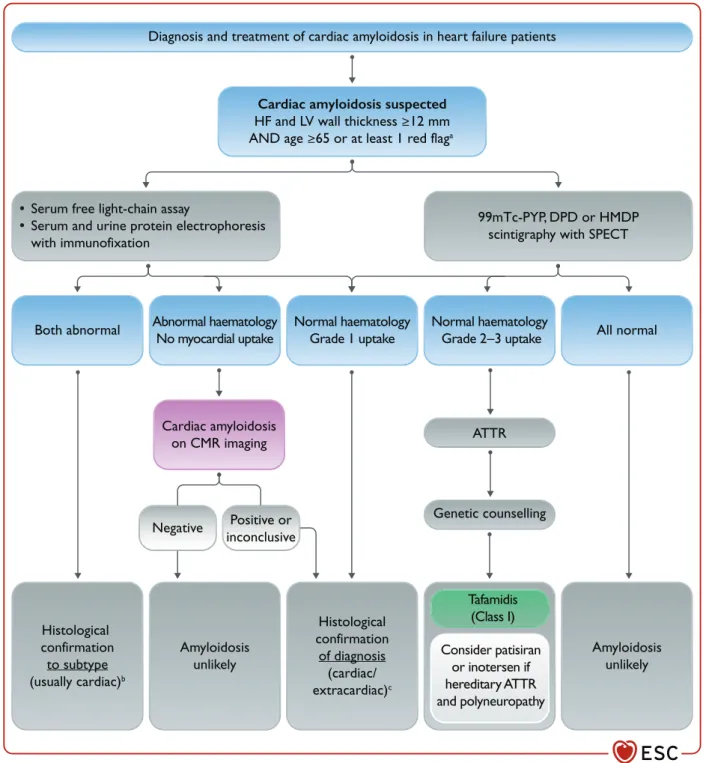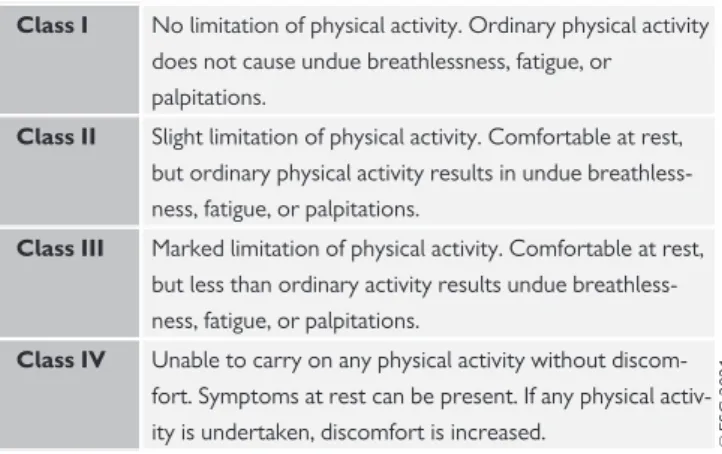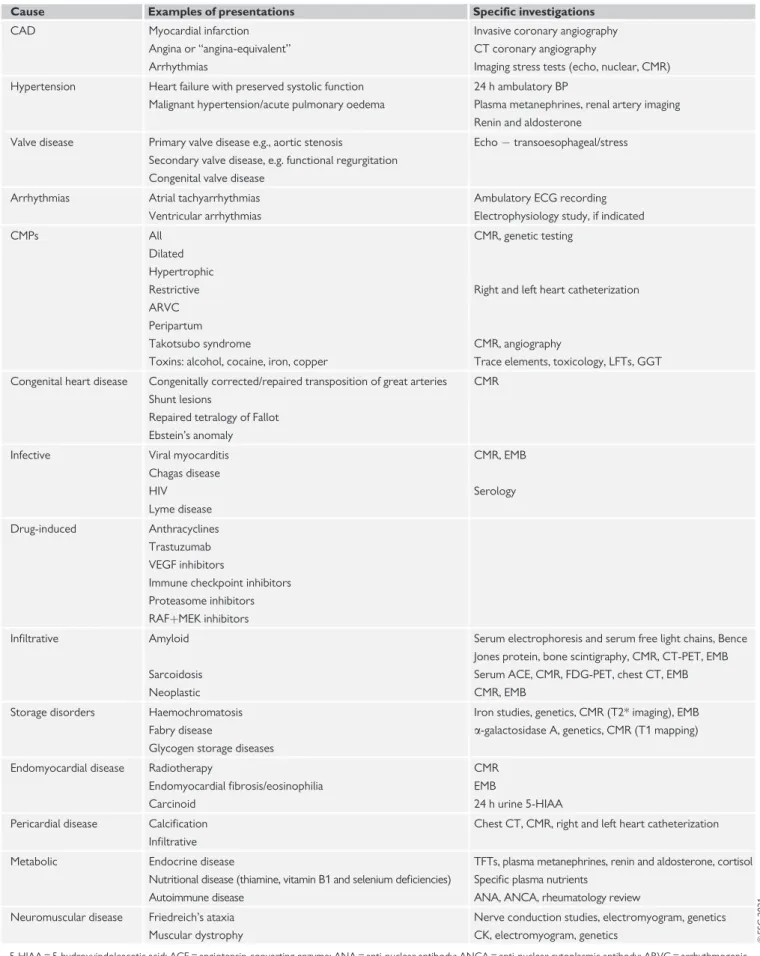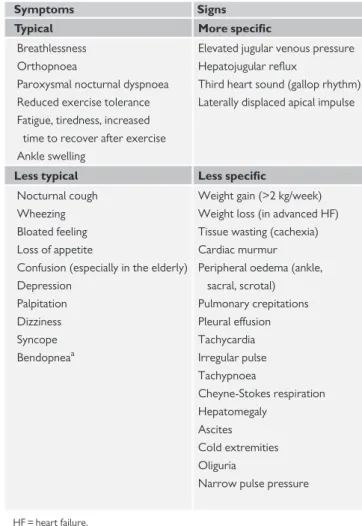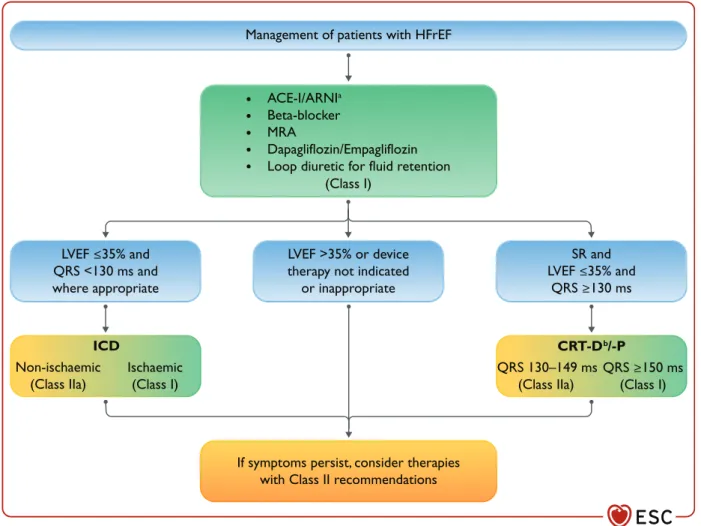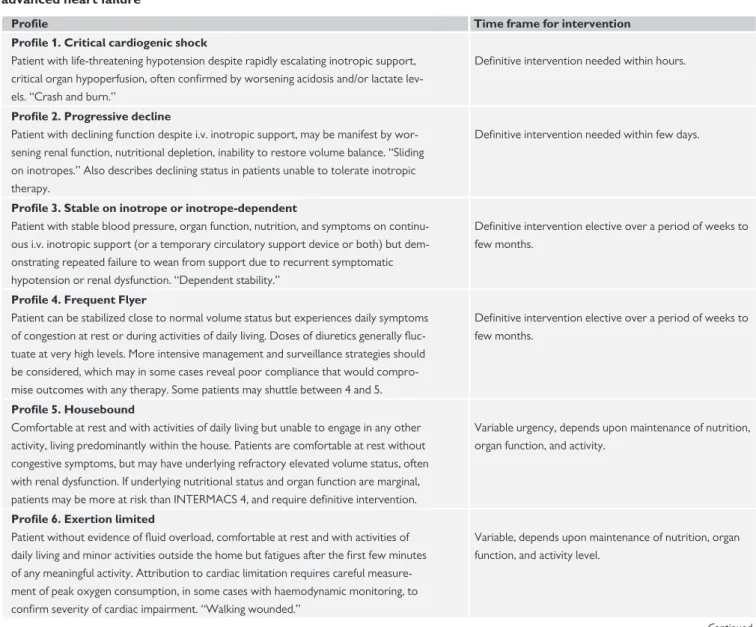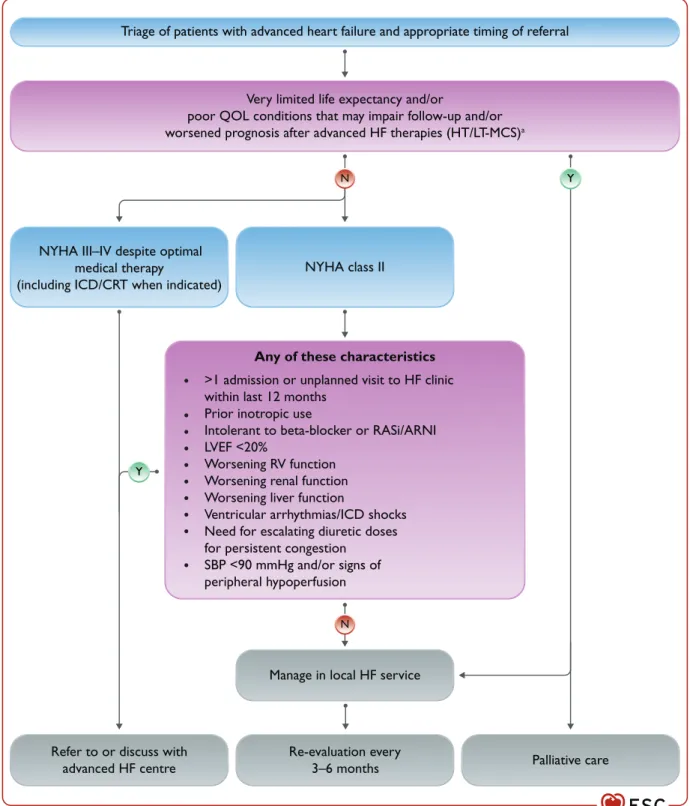CHA2DS2-VASc Congestive heart failure or left ventricular dysfunction, hypertension, age > _75 (doubled), diabetes, stroke (doubled) - Vascular disease, age 6574, sex category (female) (score). DIAMOND Patiromer for the treatment of hyperkalemia in subjects receiving RAASi medications for the treatment of heart failure (trial).
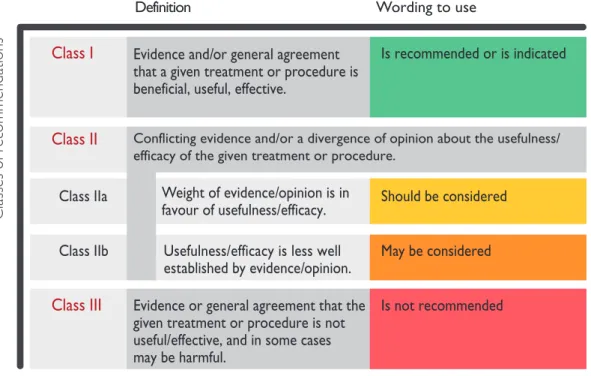
What is new
Combination of a loop diuretic with either a thiazide-type diuretic or spironolactone can be considered in patients with Short-term MCS should be considered in patients with cardiogenic shock such as a BTR, BTD, BTB.
Definition of heart failure
Terminology
- Heart failure with preserved, mildly reduced, and reduced
- Right ventricular dysfunction
- Other common terminology used in heart failure
- Terminology related to the symptomatic severity of
Those with symptoms and signs of HF, with evidence of structural and/or functional cardiac abnormalities and/or elevated natriuretic peptides (NPs), and with an LVEF > _50%, have HFpEF.
Epidemiology and natural history of heart failure
Incidence and prevalence
Aetiology of heart failure
Natural history and prognosis
Key steps in the diagnosis of chronic heart failure
BNP = B-type natriuretic peptide; ECG = electrocardiogram; HFmrEF = heart failure with mildly reduced ejection fraction; HFpEF = heart failure with preserved ejection fraction; HFrEF = heart failure with reduced ejection fraction; LVEF = left ventricular ejection fraction; NT-proBNP = N-terminal pro-B-type natriuretic peptide. Plasma concentration of B-type natriuretic peptide (BNP) 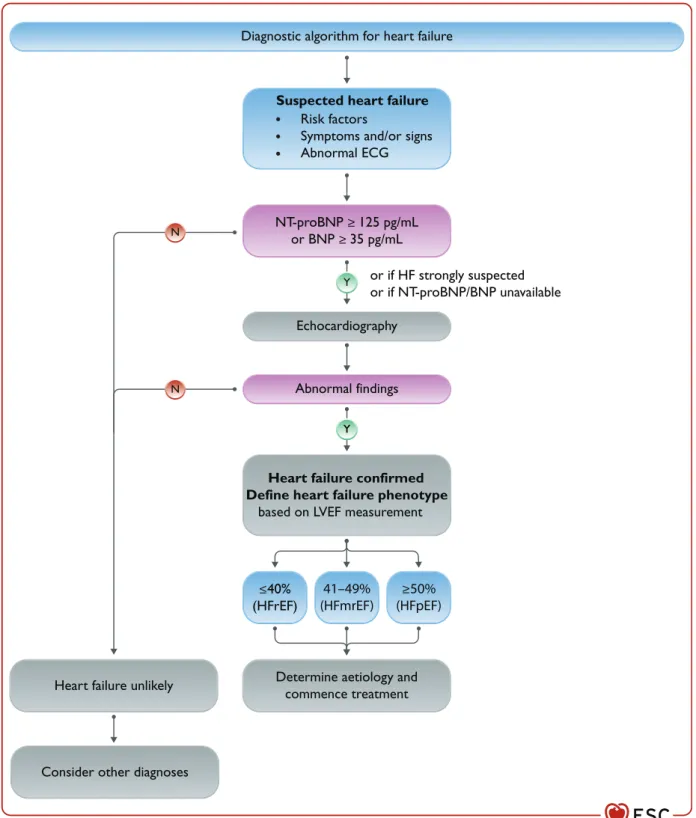
Natriuretic peptides
Use in the non-acute setting
In addition to determining LVEF, echocardiography also provides information on other parameters such as chamber size, eccentric or concentric LVH, regional wall motion abnormalities (which may indicate underlying CAD, Takotsubo syndrome, or myocarditis), RV function, pulmonary hypertension, valvular function, and markers of diastolic function .16.71.
Investigations to determine the underlying aetiology of
Computed tomography coronary angiography (CTCA) may be considered in patients with low to intermediate pretest probability of CAD or patients with equivocal noninvasive stress tests to rule out the diagnosis of CAD.5. Noninvasive stress imaging (CMR, stress echocardiography, SPECT, PET) may be considered for assessment of myocardial ischemia and viability in patients with CAD who are considered suitable for coronary revascularization.9093.
The diagnosis of heart failure with reduced ejection fraction . 3619
Goals of pharmacotherapy for patients with heart
Coronary angiography is recommended in patients with CKD who have angina pectoris or an 'angina equivalent' despite pharmacologic therapy, to establish the diagnosis of CKD and its severity. Coronary angiography may also be considered in patients with HFrEF who have an intermediate to high pre-test probability of CAD and who are considered potentially suitable for coronary revascularization.5.
General principles of pharmacotherapy for heart
Pharmacological treatments indicated in patients with heart failure (NYHA class II-IV) with reduced ejection fraction (LVEF <_40 sacubitril is recommended as a substitute for an ace-i in patients with hfref to reduce the risk of hf.>
Drugs recommended in all patients with heart failure with
- Angiotensin-converting enzyme inhibitors
- Beta-blockers
- Mineralocorticoid receptor antagonists
- Angiotensin receptor-neprilysin inhibitor
- Sodium-glucose co-transporter 2 inhibitors
An MRA is recommended for patients with HFrEF to reduce the risk of hospitalization and death from HF.121,122 I A Dapagliflozin or empagliflozin is recommended for patients with HFrEF to reduce the risk. As such, initiation of sacubitril/valsartan may be considered in ACE-I naive (ie de novo) patients with HFrEF (class of recommendation IIb, level of evidence B).
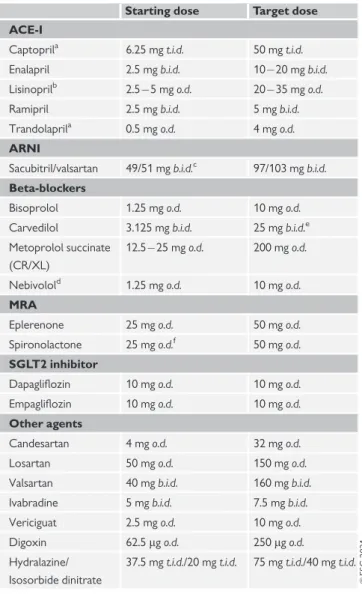
Other drugs recommended or to be considered
- Diuretics
- Angiotensin II type 1 receptor blockers
- I f -channel inhibitor
- Combination of hydralazine and isosorbide dinitrate
- Digoxin
- Recently reported advances from trials in heart
Loop diuretics are recommended to reduce the signs and/or symptoms of congestion in patients with HFrEF. The effects of digoxin in patients with HFrEF and AF have not been studied in RCTs.
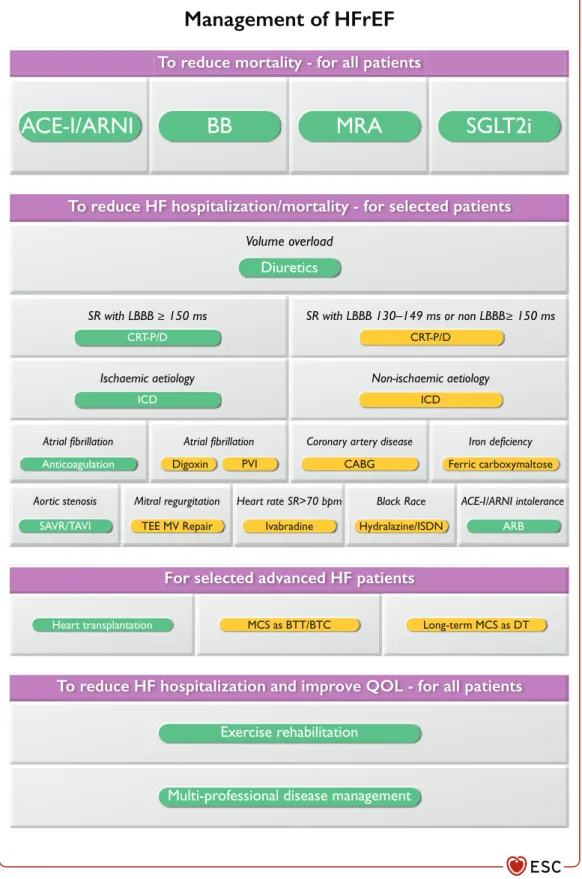
Strategic phenotypic overview of the management of
Thus, vericiguat may be considered, in addition to standard therapy for HFrEF, to reduce the risk of CV mortality and hospitalizations for HF. However, it may be considered in the future, in addition to standard therapy for HFrEF, to reduce the risk of CV mortality and hospitalization for HF.159
Implantable cardioverter-defibrillator
- Secondary prevention of sudden cardiac death
- Primary prevention of sudden cardiac death
- Patient selection for implantable cardioverter-
- Implantable cardioverter-defibrillator programming
- Subcutaneous and wearable implantable
The VICTORIA study evaluated the efficacy and safety of the soluble oral guanylate cyclase stimulator, vericiguat, in patients with reduced EF and recently decompensated CHF. Although the DANISH trial did not show a significant benefit of ICD therapy in patients with NICM, it should be remembered that NICM is a heterogeneous condition and certain subgroups (eg, laminopathies, sarcoidosis) are at higher risk of sudden death and therefore, careful consideration of ICD implantation is warranted.
Cardiac resynchronization therapy
Furthermore, in the DANISH study of patients with NICM, where 58% of patients received CRT, subgroup analysis did not show CRT-P to be inferior to CRT-D.166,167. In patients with HFrEF who have received a conventional pacemaker or ICD and subsequently develop worsening heart failure with a high rate of RV pacing despite OMT, an 'upgrade' to CRT should be considered.
Devices under evaluation
A subgroup analysis of patients with AF from the RAFT study showed no benefit of CRT-D compared with an ICD, although less than half of patients had >90% biventricular entrapment.219 Given the lack of evidence for the efficacy of CRT in patients with AF, it may be an option in in selected patients - especially those with QRS > _150 ms - which ensures the highest possible proportion of biventricular pacing. Stimulation thresholds are higher in scarred myocardium and, if possible, lead placement should be avoided in such regions.235,236 Although patients with extensive scarring actually have a poorer prognosis, there is little evidence that CRT has less prognostic benefit.211.
The diagnosis of heart failure with mildly reduced ejection
This can be prevented by CRT, which may improve patient outcomes, however, a difference in outcome was not observed between CRT and RV pacing in a subgroup analysis of RAFT.212 On balance, CRT rather than RV pacing is recommended for patients with HFrEF, regardless of NYHA class, who have an indication for ventricular pacing to reduce morbidity, although no clear effect on mortality was observed. However, AF is not an indication to perform AV node ablation in patients with CRT, except in a few cases where ventricular rate remains persistently high despite attempts at pharmacological rate control.
Clinical characteristics of patients with heart failure
Treatments for patients with heart failure with mildly
- Angiotensin-converting enzyme inhibitors
- Angiotensin receptor II type 1 receptor blockers
- Beta-blockers
- Mineralocorticoid receptor antagonists
- Angiotensin receptor-neprilysin inhibitor
- Other drugs
- Devices
Therefore, there is insufficient evidence to recommend CRT or ICD therapy in patients with HFmrEF. In HF patients with LVEF >_40%, implantation of an interatrial shunt device has been shown to be safe, and this device is subject to investigation in a larger study before any recommendation regarding its use in HFpEF or HFmrEF can be made. 251.
The background to heart failure with preserved ejection
In the DIG study10, for those with HFmrEF in SR, there was a trend toward fewer HF hospitalizations in those assigned to digoxin, but no reduction in mortality and a trend toward an excess of CV deaths. While post-hoc analyzes of landmark CRT trials suggest that CRT may benefit patients with LVEF >35%, trials of CRT for HFmrEF were discontinued due to poor recruitment.250 There are no substantial studies of ICDs for primary prevention of ventricular arrhythmias for HFmrEF; studies conducted more than 20 years ago suggested no benefit of ICD implantation for secondary prevention of ventricular arrhythmias for HFmrEF.
Clinical characteristics of patients with heart failure with
The diagnosis of heart failure with preserved ejection
Of note, patients with a history of overtly reduced LVEF ( _50% should be considered to have recovered HFrEF or 'HF with improved LVEF' (rather than HFpEF). Continued treatment for HFrEF is recommended for these patients.271 It is not known whether it is beneficial to start HF treatment in patients with recovered LVEF.
Treatment of heart failure with preserved ejection fraction
Recommendations for the primary prevention of heart failure in patients with risk factors for its development. SGLT2 inhibitors (canagliflozin, dapagliflozin, empagliflozin, ertugliflozin, sotagliflozin) are recommended in patients with diabetes at high risk of CV disease or with CV disease to prevent HF hospital admissions.293297.
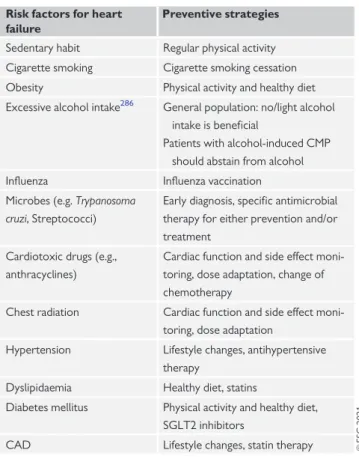
Prevention of heart failure
Multidisciplinary management of chronic heart failure
Models of care
Characteristics and components of a heart failure
Patient education, self-care and lifestyle advice
Be able to recognize the common side effects of medicines and know what actions to take. Be able to recognize common complications (including the risk of inappropriate defibrillator shocks) and know what action to take.
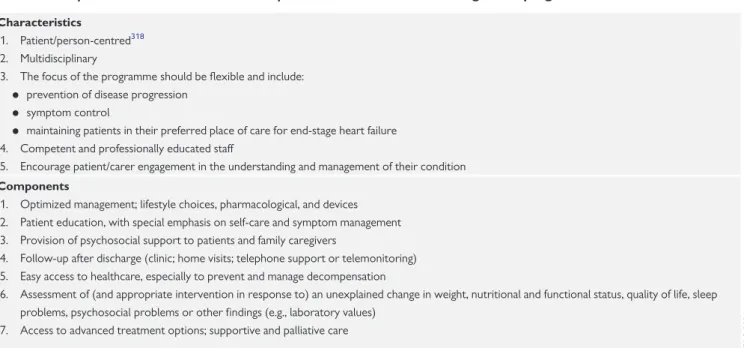
Exercise rehabilitation
Follow-up of chronic heart failure
General follow-up
Monitoring with biomarkers
Telemonitoring
There is strong evidence that monitoring can detect device failure earlier than conventional monitoring and that it can be useful for detecting arrhythmias such as AF. An increase in diastolic pressure in the pulmonary artery can be one of the earliest signs of stasis.
Epidemiology, diagnosis, and prognosis
Patients are usually required to take measurements and, as with many other aspects of HF treatment, compliance can be incomplete. If the underlying nutritional status and organ function are marginal, patients may be more at risk than INTERMACS 4 and require definitive intervention.
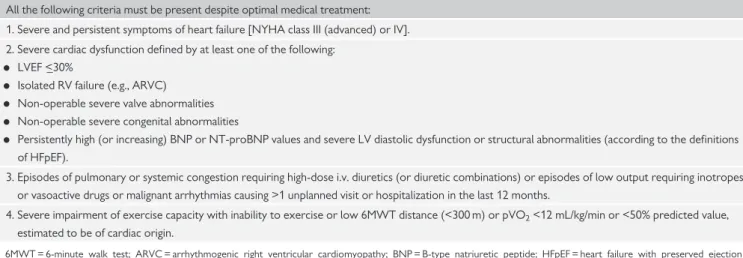
Management
- Pharmacological therapy and renal replacement
- Mechanical circulatory support
- Heart transplantation
- Symptom control and end-of-life care
Renal replacement therapy should be considered in patients with unresponsive volume overload and end-stage renal disease. In patients with low cardiac output and evidence of organ hypoperfusion as a bridge to MCS or heart transplantation, continuous use of inotropes and/or vasopressors may be considered.389,390.
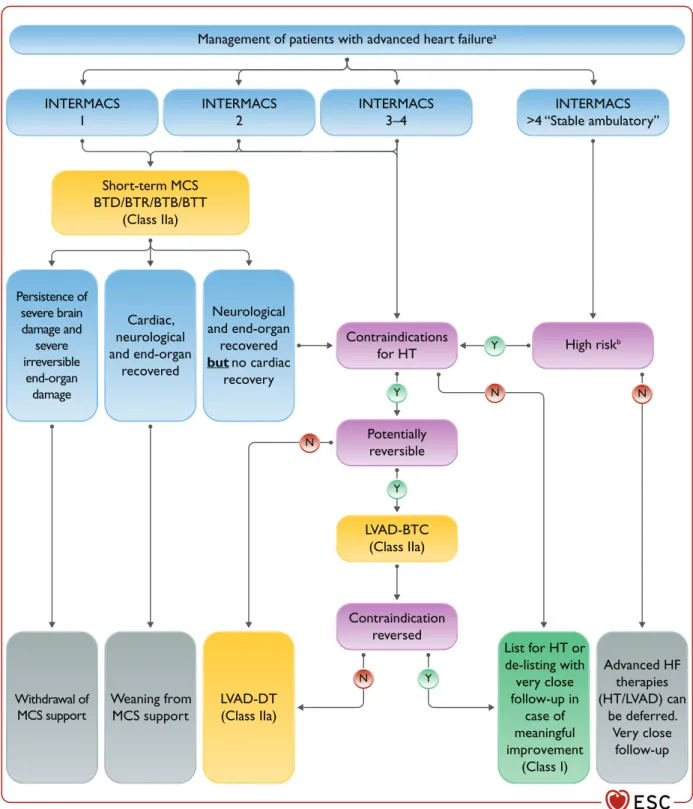
Epidemiology, diagnosis and prognosis
Plasma NP levels (BNP or NT-proBNP or MR-proANP) should be measured if the diagnosis is uncertain and a point-of-care test is available. Arterial blood gas analysis should be performed when accurate measurement of O2 and CO2 partial pressure is required (i.e. in patients with respiratory distress).
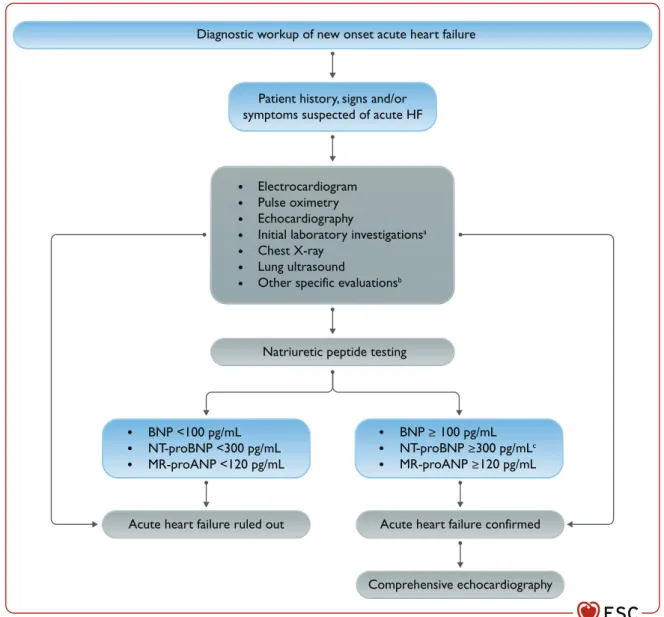
Clinical presentations
- Acute decompensated heart failure
- Acute pulmonary oedema
- Isolated right ventricular failure
- Cardiogenic shock
In some cases of advanced HF, acute pulmonary edema may be associated with low cardiac output and in this case inotropes, vasopressors and/or MCS are indicated to restore organ perfusion. Because inotropic agents can worsen arterial hypotension, they can be combined with norepinephrine if necessary (Figure 9).449.
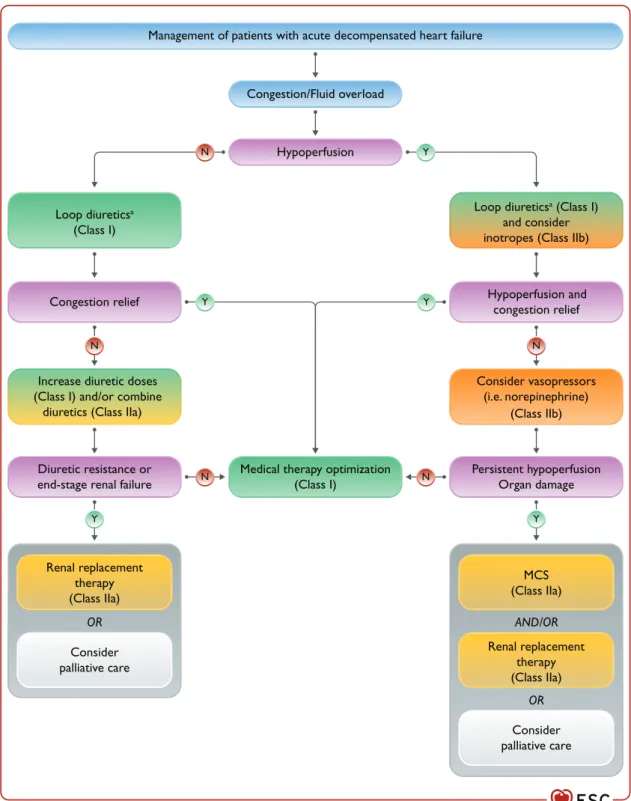
Management
- General aspects
- Oxygen therapy and/or ventilatory support
- Diuretics
- Vasodilators
- Inotropes
- Vasopressors
- Opiates
- Digoxin
- Thromboembolism prophylaxis
- Short-term mechanical circulatory support
- Pre-discharge assessment and post-discharge
A vasopressor, preferably norepinephrine, may be considered in patients with cardiogenic shock to increase blood pressure and perfusion of vital organs.485487. Recommendations for the use of short-term mechanical circulatory support in patients with cardiogenic shock.
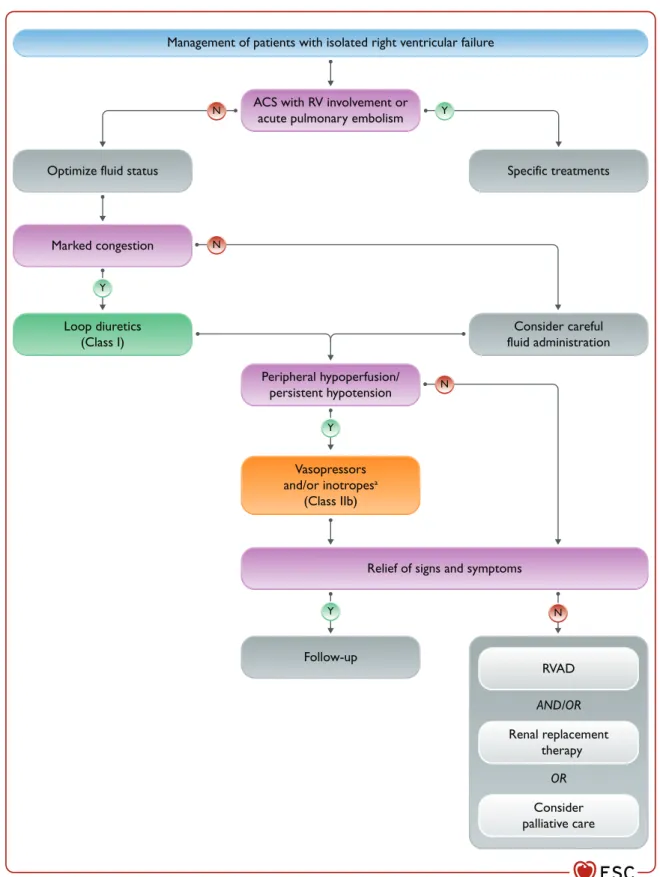
Arrhythmias and conduction disturbances
Atrial fibrillation
The RATE-AF trial compared digoxin with bisoprolol in patients with persistent AF and NYHA class IIIV symptoms. AV node ablation can be considered in patients with poor ventricular rate control despite medical treatment who are not eligible for rhythm control by catheter ablation or in patients with biventricular pacing.7,538540.
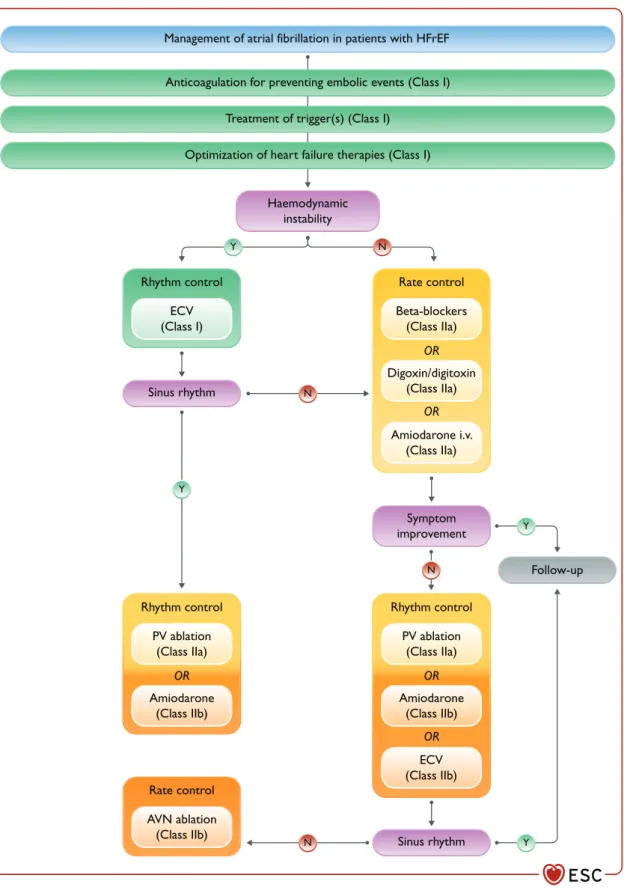
Ventricular arrhythmias
Symptomatic bradycardia, pauses and atrio-ventricular
Chronic coronary syndromes
Medical therapy
Short-acting nitrates should be used with caution in patients with HF, as they cause hypotension. An algorithm for the use of antianginal medications in patients with HFrEF is reported in Figure 15.
Myocardial revascularization
Valvular heart disease
- Aortic stenosis
- Aortic regurgitation
- Mitral regurgitation
- Tricuspid regurgitation
Aortic valve surgery is recommended in patients with severe aortic distension and HF symptoms, regardless of LVEF. In patients with severe SMR and HFrEF requiring revascularization, mitral valve surgery and CABG should be considered.
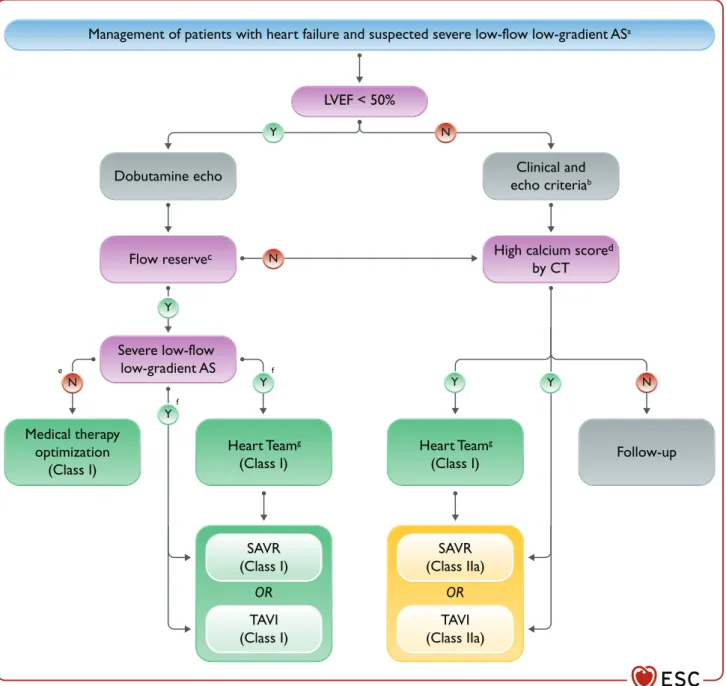
Hypertension
Tricuspid valve surgery is recommended for patients with severe TR who require left-sided heart surgery. It should also be considered in patients with moderate TR and tricuspid annulus dilatation requiring left-sided heart surgery and in symptomatic patients with isolated severe TR.592 However, surgery in isolated TR is burdened by high in-hospital mortality (8.8%) even though the advanced stage of HF may have influenced these data.624 Transcatheter techniques have recently emerged as potential treatment options for TR.
Stroke
In selected cases, transcatheter therapy and surgery may be considered.592 A multidisciplinary heart team, including HF specialists, should be considered for assessment and treatment planning.
Diabetes
Insulin is needed in patients with type 1 diabetes and to control hyperglycemia in some patients with type 2 diabetes, especially when beta cell function is depleted. It is a sodium-retaining hormone and concerns have been raised that it could worsen fluid retention in patients with HF.
Thyroid disorders
Based on these results, the SGLT inhibitors canagliflozin, dapagliflozin, empagliflozin, ertugliflozin or sotagliflozin are recommended to prevent HF and CV death and deterioration of renal function in patients with type 2 diabetes and CV disease and/or CV risk factors, or CKD. Dapagliflozin and empagliflozin are also indicated for the treatment of patients with type 2 diabetes and HFrEF (see section 5.3.5 and section 11.2.4) and sotagliflozin has been shown to reduce CV deaths and HF readmissions in patients recently hospitalized for HF.
Obesity
There are no randomized trials evaluating the efficacy of thyroid replacement therapy in subclinical hypothyroidism, but there is general agreement to correct it when TSH is >10 mIU/L, especially in patients
Frailty, cachexia, sarcopenia
Iron deficiency and anaemia
It should also be considered for reducing HF rehospitalizations in patients with LVEF
Kidney dysfunction
It is recommended that all patients with HF be routinely screened for anemia and iron deficiency with complete blood count, serum ferritin concentration, and TSAT. The benefits of ICDs may be reduced in patients with severe renal dysfunction because of the competing risk of nonarrhythmic causes of death.747749.
Electrolyte disorders: hypokalaemia, hyperkalaemia,
Water restriction was associated with improved QOL in a small, randomized study, but with only slight increases in serum sodium in an observational registry. and diuresis in patients with persistent hyponatremia and congestion. It can increase serum chloride levels and diuresis in patients with severe HF at risk of diuretic resistance. 145,794 It is currently being tested in a randomized multicenter study in decompensated HF.469.
Lung disease, sleep-disordered breathing
The infusion of hypertonic saline combined with loop diuretics has been associated with an increase in serum sodium levels and greater diuretic efficacy in small trials and observational studies.786788. Hypochloremia (
Hyperlipidaemia and lipid-modifying therapy
Because there is no evidence of harm in patients receiving statin treatment after the onset of HF, it is not necessary to discontinue statin in already treated patients.
Gout and arthritis
Erectile dysfunction
Depression
Cancer
Follow-up by heart failure or cardio-oncology team for new heart failure or left ventricular systolic dysfunction. ECG = electrocardiogram; HER2 = human epidermal growth factor receptor 2; HF = heart failure; HFA = Heart Failure Association; ICOS = International Cardio-Oncology Society; MEK = mitogen-activated protein kinase; NP = natriuretic peptide; VEGF = vascular endothelial growth factor.
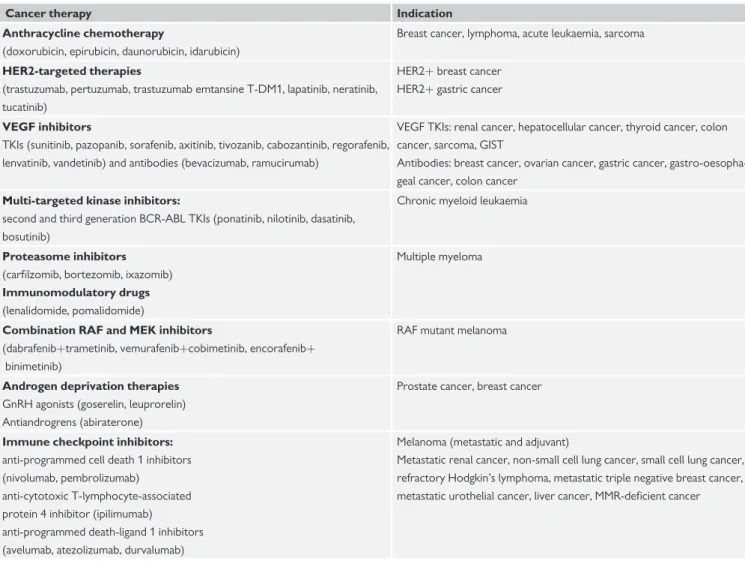
Infection
Pregnancy
Pregnancy in pre-existing heart failure
New heart failure presenting during pregnancy
In case of new HF or if there is diagnostic uncertainty, non-contrast CMR can be considered. Emergency cesarean delivery (regardless of pregnancy) should be considered with MCS immediately available.
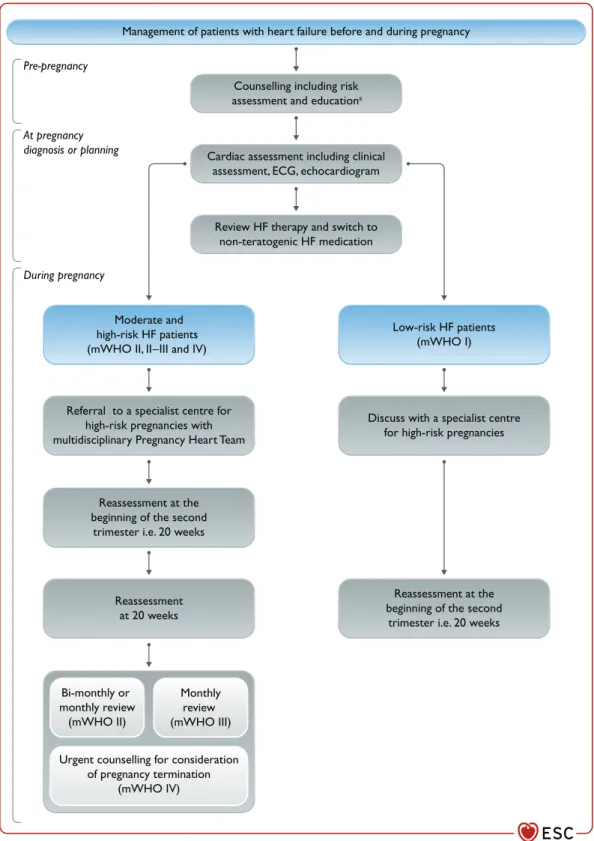
Cardiomyopathies
Epidemiology and diagnosis
Adrenergic agents (dobutamine, adrenaline) may have adverse effects.889 When a patient with PPCM is hemodynamically unstable, levosimendan or MCS may be considered. It was associated with recovery of LV function, with no difference between the two regimens and consistent with the results of a previous international PPCM registry.890,891 Bromocriptine may be considered in the treatment of PPCM.
Treatment
Higher risk of sudden cardiac death: early indication for primary prevention with ICD implantation should be considered (guided by detailed risk factors).920. The use of additional sequencing for analysis of a very large panel of genes may be considered if there is a clear family history or structural phenotype, preferably combined with familial segregation.
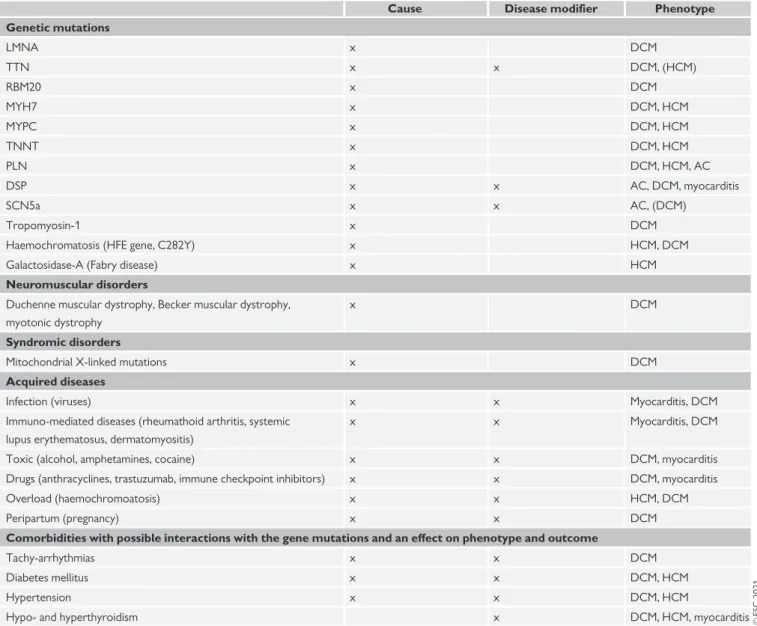
Left ventricular non-compaction
Risk models to predict ICD benefit were used in patients enrolled in DANISH and may help guide the indication for ICD implantation in DCM.166,913 Treatment of HCM and AC, including indications for ICDs, has been described in detail in previous papers. Therefore, LVNC is not considered a separate disease entity, but a separate rare presentation of genetic susceptibility to HCM or DCM.939.
Atrial disease
Definition
Quite often, individuals with LVNC features are found in families where other affected relatives have typical HCM or DCM.
Diagnosis
Management
Myocarditis
Epidemiology and diagnosis
Treatment
Amyloidosis
Epidemiology and diagnosis
ACS = acute coronary syndrome; AV = atrio-ventricular; CAD = coronary artery disease; CMR = cardiac magnetic resonance; CMV = cytomegalovirus; CRP = C-reactive protein; CTCA = computed tomography coronary angiography; ECG = electrocardiogram; EMB = endomyocardial biopsy; HF = heart failure; HIV = human immunodeficiency virus;. ACS = acute coronary syndrome; CAD = coronary artery disease; CAG = coronary artery angiogram; CMR = cardiac magnetic resonance; CT = computed tomography; ECG = electrocardiogram; EMB = endomyocardial biopsy;.
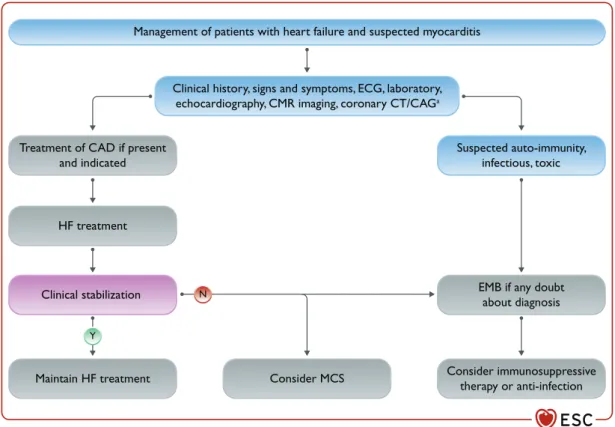
Therapy of amyloidosis and heart failure
Iron overload cardiomyopathy
Additional iron-induced complications, such as liver disease and endocrine abnormalities, further contribute to cardiac deterioration.986,987 The end result is the development of iron overload. Myocardial iron deposition can be accurately estimated by the CMRT2* technique; T2* values are correlated with left and right ventricular systolic function and predict the development of iron-induced HF or arrhythmias.984 Prevention of IOCM is successfully accomplished with iron chelators, including deferoxamine, deferiprone, and deferasirox, while IOCM is established. can be completely reversed by intensified and combined iron chelation therapy.985.
Adult congenital heart disease
No benefit of the obesity paradox for diabetic patients with heart failure. Eur J Heart failure. Iron deficiency: an ominous sign in patients with systolic chronic heart failure. Eur Heart J.
